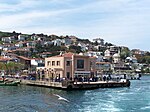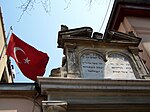Monastery of the Transfiguration, Kinaliada
11th-century Eastern Orthodox church buildingsAdalarChurches and monasteries of ConstantinopleGreek Orthodox churches in Istanbul

The Monastery of the Transfiguration, known locally as Hristo [Christ] Monastery, is a prominent Greek Orthodox monastery that has served the Greek Orthodox community of Constantinople (modern Istanbul) since the time of the Byzantine Empire. The monastery is located on the island of Kınalıada, one of the Prince Islands in the Sea of Marmara. It is situated on one of the highest peaks on the island called Hristo Peak (93 meters), which is named after the Monastery. The Monastery is especially known as a destination for exiled Byzantine Emperors in the 11th century.
Excerpt from the Wikipedia article Monastery of the Transfiguration, Kinaliada (License: CC BY-SA 3.0, Authors, Images).Monastery of the Transfiguration, Kinaliada
Manastır Sokağı,
Geographical coordinates (GPS) Address Nearby Places Show on map
Geographical coordinates (GPS)
| Latitude | Longitude |
|---|---|
| N 40.905869 ° | E 29.050243 ° |
Address
Hristo Rum Ortodoks Manastırı
Manastır Sokağı
34977 , Kınalıada Mahallesi
Turkey
Open on Google Maps






